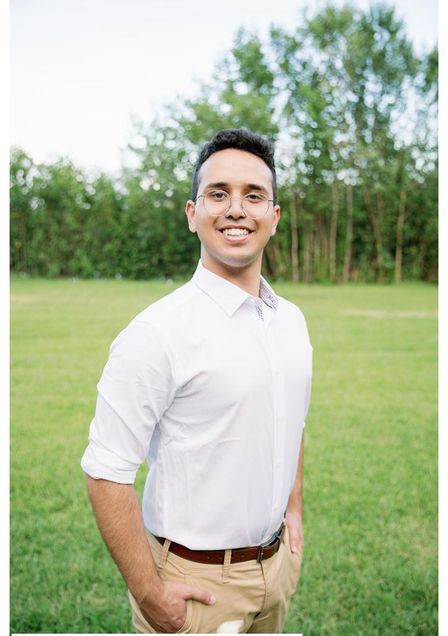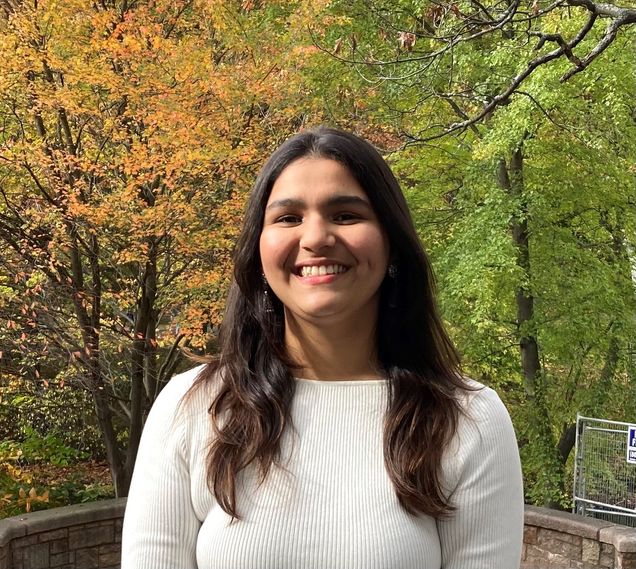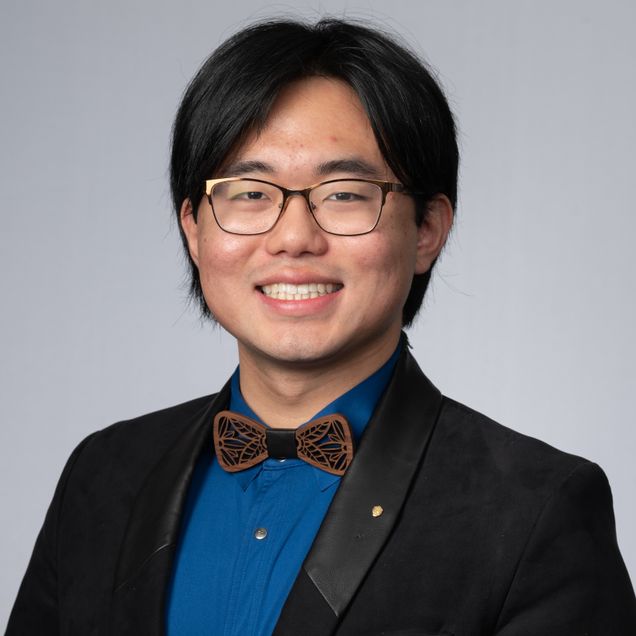Undergraduate Student Researchers Push the Boundary
CAS students delve into research on black holes, eating disorders, and how attention affects the way we hear
CAS students delve into research on black holes, eating disorders, and how attention affects the way we hear
Each semester, several hundred Boston University undergraduates participate in the Undergraduate Research Opportunities Program (UROP), which connects BU undergraduate students with funded, faculty-mentored research experiences. Below are the stories of three College of Arts & Sciences students — Juneau Wang (CAS’24, GRS’24), Angel Morales (CAS’25), and Soumya Sathe (CAS’24) — who took part in the program over summer of 2023.

Angel Morales (CAS’25) spent 10 weeks drawing circles around blobs.
That’s the explanation he likes to give, anyway.
In reality, Morales, a junior majoring in astronomy and physics, studied what are known as blazars — supermassive black holes that are surrounded by disks of matter under gravitation’s influence whose jet is pointing in Earth’s general direction. He also looked at jets of plasma, a state of matter, that are generated by blazars and point in the general direction of Earth.
“If you imagine a hose that’s spraying out water, the core is the very edge of the hose where the water is coming out,” Morales said. “You can think of the jet as being the water that’s being ejected.”
Pockets of plasma move along jets and can be ejected toward Earth. When they are ejected, the plasma stays relatively intact, allowing researchers to track their motions and study how jets behave.
“The really mysterious thing is that we don’t know why jets form,” Morales said. “Not all super massive black holes have them.”
Morales tracked the movement of the plasma using a system of 10 radio telescopes to understand how jets behave and function, as well as how the plasma moved and changed over time.
In the images Morales studied, the pockets of plasma appeared much brighter than the surrounding gas and grouped-up to form the blobs. Morales wanted to track how the plasma changed position from week to week and month to month. When the blobs in the images shifted, Morales circled them.
Morales went through this process for 10 weeks, and once he collected enough data he created a plot to determine if the plasma’s ejection correlated with gamma ray flares from the jet. He is now working to put together a numerical representation for further analysis.
“My goal was to advance as much as we knew,” Morales said. “Hopefully what I do will make it easier for professionals to be able to understand these blazars, and in turn I’d be able to understand them better and just gain knowledge about these things.”

Soumya Sathe (CAS’24) wants to get her PhD in clinical psychology and focus on clinical psychology practice. But before starting on this path, she first needed to conduct some preliminary research.
“I have known people with eating disorders, and I’ve had body image concerns of my own, so that was always a topic that interested me,” Sathe said.
Sathe started a directed study project in January 2023 to examine literature on eating disorders under the mentorship of Anthony Rosellini, a research assistant professor in psychological & brain sciences. She learned that experts understood the general factors that increase the risk of developing an eating disorder, such as body image dissatisfaction, but knew less about the risk factors associated with individual eating disorders.
Sathe decided she wanted to understand what factors go into developing an eating disorder, so she applied to conduct UROP research to study the symptoms of anorexia, bulimia, and binge eating.
To conduct her research, Sathe used data from existing studies dating back to 2003. These studies — which she accessed through the Center for Anxiety and Related Disorders — examined anxiety and depression and didn’t address eating disorders directly; however, they did give diagnostic information about the studies’ participants, so Sathe knew which participants were also diagnosed with an eating disorder.
“I wanted to get a bird’s eye picture of personality and emotional factors that are differentially associated with these eating disorders,” Sathe said.
Sathe drew from studies that administered tests related to personality factors and emotional regulation factors. She analyzed the data collected from these tests to determine the risk factors and symptoms of eating disorders and identified 294 cases of eating disorders, 229 of which had information regarding the type of symptoms participants disorders. In this data, Sathe identified associations between certain traits and disorders.
Sathe found that stress control was significantly higher with anorexia than with bulimia or binge eating. This was consistent with the idea that anorexia is associated with heightened control or cognitive inflexibility. She also determined that people with anorexia were significantly more conscientious than participants with other eating disorders.
These traits made sense to Sathe. What was unexpected, however, was an apparent link between extraversion and anorexia and bulimia, which was not a correlation she had seen before. This observation suggested that food restriction and compensatory behaviors — such as over-exercising — may be linked to a need for social approval, which is something introverted people may not desire, Sathe said.
Sathe’s conclusions are provisional because of data limitations, but for now this is acceptable — Sathe’s objective wasn’t to define concrete symptoms of eating disorders but to identify what data and methods could lead to solid results and determine the measures she needed for her honors thesis research.
She now plans to use these findings as the launching point for her honors thesis research, for which she hopes to collect primary data from participants with eating disorders and potentially find similar trends to those she has already observed.
“Eating disorders are something I now know a weird amount about, but I also know what we don’t know in the field, which is also a lot,” Sathe said.

Sounds are all around us, from the blare of a car’s horn, to a clock’s ticking, to a phone’s ringing. All of these sounds tell us information: a driver is sending a warning, time is passing, someone is calling.
To many people, these are simply the sounds of everyday life, but Juneau Wang (CAS’24, GRS’24) hears them differently.
As a musician and biology student, Wang is interested in understanding the human experience and how the sounds around us affect our attention.
Connecting his experiences performing in the BU Bands and the Times Arrow New Music Ensemble, which require real-time attention to sounds, “I really realized how important attention was in our everyday life,” Wang said. “I wanted to know a little bit more about how we perceive the world around us.”
Wang started studying the relationship between sounds and attention during the spring 2021 semester. He designed an experiment with Assistant Professor of Psychological & Brain Sciences Rachel Denison to study how paying attention to moments in time affects the way we hear.
While researchers have conducted studies linking hearing and attention before, there has been less research investigating how our attention to moments in time affects our hearing.
Twenty participants took part in Wang’s study, returning for tests periodically over the course of several months.
During the tests, participants sat in a dark room with a computer and a keyboard and wore headphones over their ears. Wang played two sounds one after the other, each just 30 milliseconds long, that either swept up or down in frequency, “almost like a bird chirp.”
Before each trial, Wang first asked the participants to pay attention to one of two sounds, or to both sounds. After both sounds were played, Wang then asked participants to recall whether one of the sounds swept up or down. He noticed that participants struggled to correctly remember the first sound when they were instructed to pay attention to the second. But when he asked them to recall the second sound after only paying attention to the first, they performed better—closer to the performance as if they were paying attention to the second sound all along.
These results suggested to Wang that people were most effective at using their attention to enhance the first sound in the sequence.
“We saw that if you are already paying attention [to the first sound], you can answer to the second sound with as good of a performance,” Wang said. When it comes to hearing, “maybe you’re able to turn on attention like a switch before the first sound and it’ll stay on a little bit longer if you need to report the second sound.”
“In the future, we want to see whether combining sounds across time, kind of like stringing music notes to make a song melody, affects the way we perceive the moments before and after we pay attention,” Wang said.